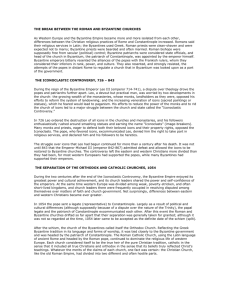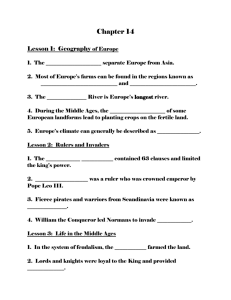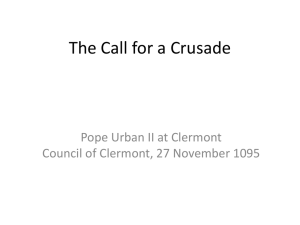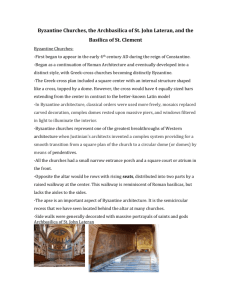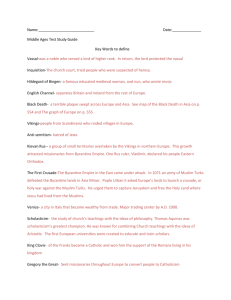The Byzantine Church
advertisement
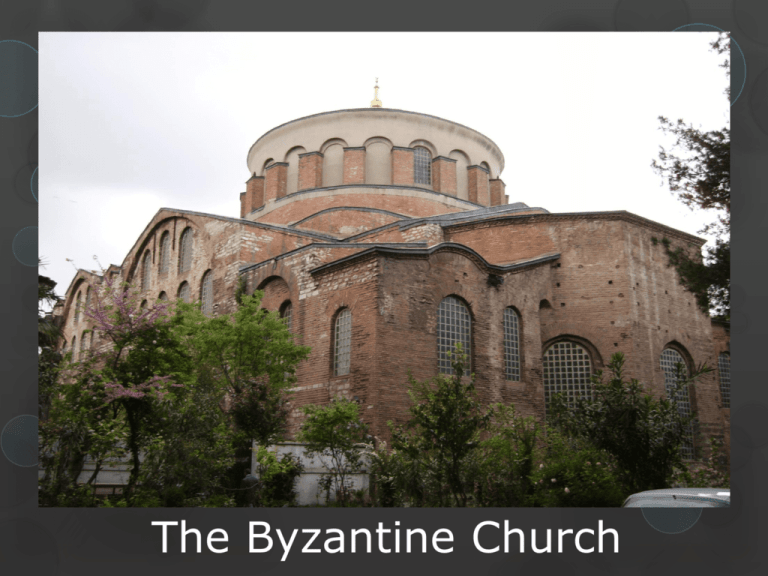
The Byzantine Church The Byzantine Church Main Idea: Church and Government worked closely together during the Byzantine Empire. The Byzantine Church Lecture Focus: In the United States, religion and government are separated however during the Byzantine Empire religion and government had a different relationship. http://www.boston.com/bigpicture/2009/01/the_inauguration_of_president.html The Byzantine Church As you learned earlier, the church of Rome survived the fall of the Western Roman Empire. Its head, the Pope, became the strongest leader in Western Europe. The Byzantine Church Under the Pope, the Latin churches of the region became known as the Roman Catholic Church. In the east, however, the Roman Empire continued and developed into the Byzantine Empire. The Byzantine Church Like Roman Catholics in the west, the Byzantines developed their own form of Christianity. It was based on their Greek heritage and was known as the Eastern Orthodox Church. Church and State Church and government worked closely together in the Byzantine Empire. The Byzantines believed their emperor represented Jesus Christ on Earth and this emperor was in charge of religious ceremonies. Church and State The emperor also chose the patriarch of Constantinople, the leading church official in the Byzantine Empire. In this way, the emperor controlled the church as well as the government…which is the opposite of what we are used to in the United States. Church and State Byzantines believed that God wanted them to preserve and spread Christianity…all church and government officials were united in this goal. Church and State Questions: 1) Who was the leading church official in the Byzantine Empire? 2) How is this different from the United States? Church and State Questions: 1) Who was the leading church official in the Byzantine Empire? The Emperor was the head of both the government and the church 2) How is this different from the United States? The president is just in charge of the government and not any religion Religious Arguments Many Byzantines, from the Emperor down to the poorest farmer, were very interested in religious matters. In homes and shops, they argued about religious questions…for example Byzantines loved to discuss the exact relationship between Jesus and God. Religious Arguments In the 700’s C.E., a major dispute divided the Church in the Byzantine Empire. The argument was over the use of “Icons” Religious Arguments Icons are pictures or images of Jesus, Mary (the mother of Jesus) and the saints, which are holy Christian people. Many Byzantines honored icons. Religious Arguments Icons would cover the walls of Byzantine homes, shops and of course Churches. A few icons were even believed to inspire “miracles”. Religious Arguments Some Byzantines, however, wanted an end to the use of icons. They thought that honoring them was a form of “idol” worship, which was forbidden by God. Religious Arguments The supporters of icons, however, claimed that icons were symbols of God’s presence in daily life. These images, they would also say helped explain the religion of Christianity to people. Religious Arguments Emperor Leo III did not approve of icons. In 726 C.E., he ordered all icons removed from churches. Religious Arguments Government officials that carried out his orders were known as “Iconoclasts”, which means image breakers. We use this word today to mean someone who attacks old fashioned beliefs or institutions. Religious Arguments Most Byzantines, many church leaders, and even the Pope in Rome opposed Emperor Leo III order. In fact, the dispute over icons damaged ties between the churches of Rome and Constantinople. Religious Arguments Over the next 100 years, the argument cooled and the use of icons became accepted once again. They are still an important part of the Eastern Orthodox religious practice to this day. Religious Arguments Questions: 3) What does the term “Icon” mean when talking about the Byzantine Church? 4) Why did some people not want to use “Icons” in everyday life? 5) What does the term “Iconoclast” mean? Religious Arguments Questions: 3) What does the term “Icon” mean when talking about the Byzantine Church? Are pictures or images of Jesus, Mary and Saints 4) Why did some people not want to use “Icons” in everyday life? People thought it was a form of “Idol Worship” that was forbidden by god 5) What does the term “Iconoclast” mean? Someone who attacks old-fashioned beliefs Conflicts Between Churches Icons were not the only issue that caused bitterness between the churches of Constantinople and Rome. The most serious argument was about how churches were to be run. Conflicts Between Churches The most serious argument was how the churches were to be run…the pope claimed that he was the head of all Christian Churches. The Byzantines did not accept the Pope’s claim. Conflicts Between Churches They believed the patriarch of Constantinople and other bishops were equal to the Pope. Conflicts Between Churches Making matters worse was the fact that each church sometimes refused to help the other when outsiders attacked. In the late 700’s C.E., the Byzantine Emperor refused to help the Pope when Italy was invaded. Conflicts Between Churches The Pope turned instead to a Germanic people from Northern Europe called the Franks for help. The Franks were Roman Catholics and loyal to the Pope. Conflicts Between Churches The Pope was grateful to the Franks for stopping the invasion, In 800 C.E., the Pope gave the Frankish King, Charlemagne, the title of Emperor. Conflicts Between Churches This angered the Byzantines very much. They believed the leader of the Byzantines was the only true Roman Emperor. Conflicts Between Churches This conflict pointed out the differences in how each church felt about relationships with the government. In the Byzantine Empire, the emperor was in control, with church leaders respecting his wishes. Conflicts Between Churches In the West, however, the pope claimed both spiritual and political power…he often quarreled with kings over the church and government affairs. Conflicts Between Churches Finally, after centuries of tension, the Pope and the patriarch of Constantinople took a drastic step in their ongoing feud. In 1054 C.E., they excommunicated each other. Conflicts Between Churches Excommunication means to declare that a person or group no longer belongs to the church. This began a “schism”, which means separation, of the two most important branches of Christianity. Conflicts Between Churches The split between the Roman Catholic Church and the Eastern Orthodox Church has lasted to this day!!! Conflicts Between Churches Questions: 6) Who was Charlemagne and what did he do for the Pope? 7) What does the term “Excommunicated” mean? 8) What does the term “Schism” Conflicts Between Churches Questions: 6) Who was Charlemagne and what did he do for the Pope? Frankish King who helped stop an invasion of Italy 7) What does the term “Excommunicated” mean? To declare that a person or group no longer belongs to the church 8) What does the term “Schism” Separation, between churches Conflicts Between Churches Reading Check: How did Church and government work together in the Byzantine Empire? Answer in a complete, well planned paragraph.
